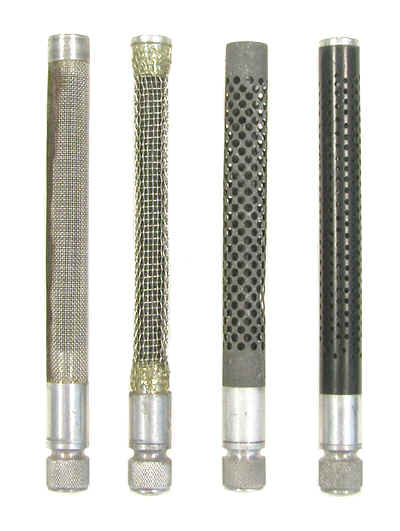Prototype ORNL Beta Dosimeters (early 1950s)

The pocket chambers and dosimeters of the 1940s and 1950s were designed for providing convenient measurements of worker exposures to gamma rays and X-rays. Nevertheless, it was recognized that the beta dose to the skin, which could be significant, was not being indicated because the chamber walls were sufficiently thick to completely stop beta particles under 1 MeV or so.
In 1953, Oak Ridge National Laboratory tried to solve this problem by the use of beta-sensitive thin-walled dosimeters. The chamber wall of these dosimeters was made from electrically conductive paper 7 mg/cm2 in thickness. This thickness corresponds to the depth of the germinal layer of skin, the tissue of concern.
To provide mechanical strength, the paper wall was housed inside an outer perforated metal or plastic wall. The photograph shows, from left to right, dosimeters with a stainless steel screen outer wall, an aluminum screen wall, a perforated magnesium (?) wall, and a drilled plastic wall.
The remaining components of the dosimeters, the central electrode, the insulators, the charging contacts, etc., came from standard Victoreen pocket chambers.
The steel screen turned out to be unsatisfactory because its high atomic number promoted photoelectric interactions in the presence of gamma rays. The resulting photoelectrons would deposit energy in the chamber and complicate its response.
The aluminum screened chamber was too flimsy for routine field use. The plastic walled chamber had too complex a response because the chamber was responding to betas with a degraded energy spectrum that had penetrated the plastic. Either the betas should pass through the holes in the outer wall or be completely stopped. Perforated aluminum (not in the collection) and perforated magnesium walls turned out to be the best choices.
The suggested protocol for using the dosimeter was to wear a standard pocket chamber to determine the gamma dose and to subtract this from the dose determined with the beta chamber (which also responded to gamma rays). To be conservative, the difference in the two measurements, which presumably represented the beta only dose, was to be multiplied by two to account for a possible under-response.
Later on, the Victoreen Company made a commercial version of this dosimeter, the Victoreen Model 754.
Size: 5.25 long x 0.5" diameter
Donated by Oak Ridge National Laboratory.
References
- Gupton, E.D., Pocket Covered Pocket Dosimeter, Oak Ridge National Laboratory, Inter-company Correspondence. Nov. 11, 1953.
- Hubbell, H.H., Johnson, R.M., and Birkhoff, R.D., Beta-sensitive personnel dosimeter. Nucleonics, February 1957, p. 85.
